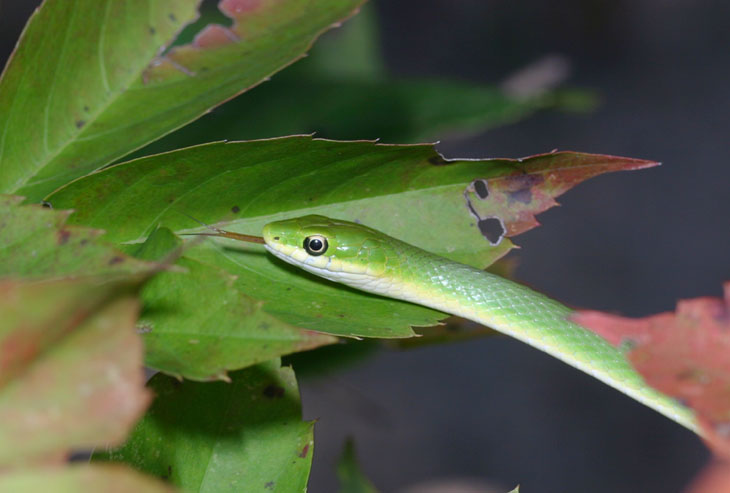 I know, I know, I go from bugs to snakes – more of a lateral move instead of an improvement, but chill; something else may be coming soon.
I know, I know, I go from bugs to snakes – more of a lateral move instead of an improvement, but chill; something else may be coming soon.
I see about one of these a year, and it seems to be about this time, too. I’m not aware of anything that would make rough green snakes (Opheodrys aestivus) appear in early autumn, so I’m going to guess this is only coincidental. I found it in the exact same location as the black rat snake earlier this year, too – fences overgrown with vines are ideal spots for snakes. But not so much for getting the best photos, so I captured this one and set it loose for the photo session in the dog fennel plants in the open yard. These are the same plants that have been hosting so many of the arthropod photos that I’ve posted earlier, and they served their purpose amazingly well.
Rough green snakes ‘know’ that they blend in much better in foliage than on the ground, and tend to seek height when threatened, even if the ground offers plenty of hiding spots, so this one moved quickly into the upper reaches of the fern-like plant. Since the plants run about 2 1/2 meters (8 ft) tall, this meant my subject was a little above me but not out of reach, and sealed off from escape by my presence below, so I was able to shoot dozens of frames. The down side of this is that the stalks are very slender and flexible; the negligible weight of the snake didn’t affect things too much, but the stiff breeze did, and the snake continually swayed in and out of focus. But my position beneath the snake allowed me to get some nice sky color in the frames, and some interesting positions as well.

I was still on manual flash settings from chasing insects, so I made some hasty adjustments to the light level and balanced it adequately to the ambient sunlight. I suspect no small number of photographers can see that supplemental lighting was used – there wouldn’t be this much light available when shooting from the underside towards the bright sky – but I don’t think it’s so harsh that it looks wrong. The biggest telltale is the shadow of its own head thrown onto the first curve of the body, but had you noticed that before I mentioned it?
 One thing that the setting doesn’t provide is any sense of scale at all, so I resorted to my usual trick – I think there are more photographs of my left forefinger, followed closely by the neighboring thumb, than there are of my face. This is certainly true of the images that I’ve taken, but perhaps this is not especially profound.
One thing that the setting doesn’t provide is any sense of scale at all, so I resorted to my usual trick – I think there are more photographs of my left forefinger, followed closely by the neighboring thumb, than there are of my face. This is certainly true of the images that I’ve taken, but perhaps this is not especially profound.
You’re not looking at a juvenile specimen, by the way, but a full-grown adult – this one is about average size, and roughly 60 cm (2 ft) in length. They have a distinctively slender profile, with very little change in girth throughout their length, which lets them blend in with vines and even the tall grasses. The only defense exhibited, aside from trying to dart away quickly, was the typical snakely trait of pooping on me; this is a memorable odor that’s very hard to get rid of, and I think I might have preferred that it tried biting instead.
Notable, to me at least, was that this is one of the few I’ve found who appeared to be free of battle scarring on its body. Many adult snakes display scars and wounds from encounters, either with predators or prey, and to my experience this holds especially true of rough green snakes, but this one showed only the slightest evidence of such, which was a tiny scar along its jaw. I’ll let you decide if this is talent, luck, or charm; it certainly was none the worse from its encounter with me, since I set it loose back where I had first found it when I was done. My last pics also netted something that is more difficult than you might imagine, which is catching the tongue out. This is a very brief display most times, often retracted by the time the shutter can be tripped, and snakes rarely do it when they feel threatened, so usually this has to be captured as they’re disappearing into cover, like it was here. The tiny hook-shaped scar can just be made out underneath the eye.





















































